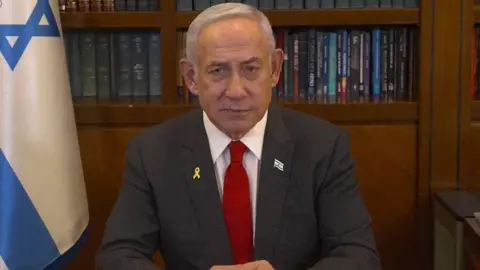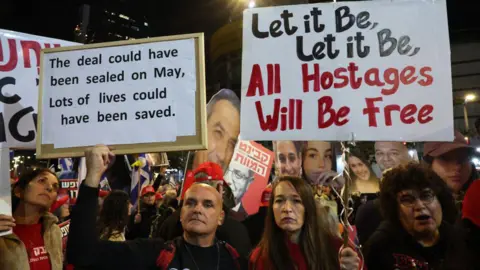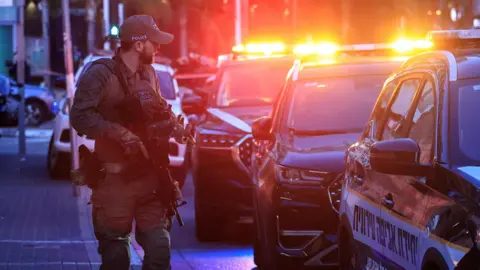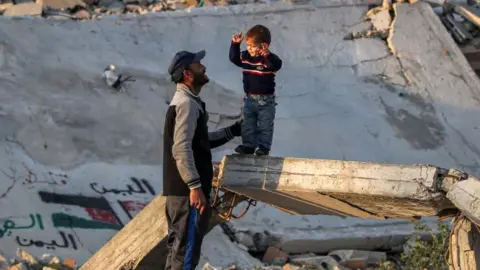 Office of the Israeli Prime Minister
Office of the Israeli Prime MinisterIsraeli Prime Minister Benjamin Netanyahu said his country was ready to resume war against Hamas if negotiations for a second phase of the ceasefire fail.
In a televised speech just hours before it began Sunday, Netanyahu stressed that the ceasefire was “temporary” and that Israel reserved the right to resume strikes in Gaza – and that he had the president’s support elected American Donald Trump to do so.
Netanyahu also highlighted what he called the success of Israel’s military campaign over the past 15 months: including the assassination of Hamas leader Yahya Sinwar.
“We have changed the face of the Middle East,” Netanyahu said, before adding that Hamas was now “completely alone.”
The ceasefire is expected to come into effect at 8:30 a.m. local time (06:30 GMT).
Before Saturday’s speech, Netanyahu said Israel would not implement the deal until it received the list of hostages to be released by Hamas.
“Israel will not tolerate violations of the agreement,” he said.
A longer list of the 33 hostages to be released by Hamas has already been published by Israeli media but has not been confirmed by officials.
But Israeli authorities say they have not yet received the names of the three hostages who are to be released on Sunday.
Meanwhile, Israel has continued airstrikes on what it says are Hamas and Islamic Jihad sites in Gaza – more than 120 people have been killed since the deal was announced on Wednesday, according to Hamas officials. .
In the coming weeks, the 33 hostages are expected to be released in exchange for 1,890 Palestinian prisoners. Under the terms of the agreement, Israel will also begin withdrawing its forces from Gaza.
It is not clear where the first hostages will be handed over. A senior Israeli military official said three reception points had been prepared near the border in northern, central and southern Gaza.
Previously, a source close to Hamas told the AFP news agency that the first three hostages released would be women.
 Getty Images
Getty ImagesTalks on the terms of the second phase of the ceasefire are expected to begin on the 16th day of the first phase and will focus on establishing a “permanent end to the war.”
Details of the second phase of the deal are still uncertain, but it is expected that the remaining hostages, including men, will be released at this stage, as more Palestinian prisoners held in Israeli jails are released. released.
There would also be a complete withdrawal of Israeli troops from Gaza. It is also understood that Hamas police – who will not be armed unless absolutely necessary – will manage the return of hundreds of thousands of displaced Palestinians to northern Gaza.
The third and final stage will involve the reconstruction of Gaza – which could take many years – and the return of the bodies of the remaining hostages.
Friday evening, The Israeli government approved the ceasefire agreement and the release of hostages after hours of discussions.
Two far-right ministers voted against, including National Security Minister Itamar Ben-Gvir.
The drawn-out structure of the deal is also causing concern and division among the hostages’ families. Some fear that their loved ones will be abandoned in Gaza once the first phase ends.
On Saturday evening, thousands of protesters gathered in Tel Aviv to demand that the government guarantee the release of more hostages by respecting the first phase of the ceasefire.
Gal Alkalay, a member of the Hostages and Missing Families Forum, told the Reuters news agency: “We could have saved the lives of 200 soldiers and more than 10 hostages.” She added that people died needlessly because the government “couldn’t make a decision and waited for Trump.”
 Reuters
ReutersEarlier Saturday, several people were injured in a stabbing attack near a restaurant in Tel Aviv, Israeli police said. The attacker was reportedly shot dead on the spot by a civilian.
The suspect arrived “illegally” in Tel Aviv from Tulkarem, in the occupied West Bank, Israeli media reported.
 Getty Images
Getty ImagesThere has been no respite for Palestinians on the ground in Gaza since the ceasefire agreement was announced Wednesday evening.
The Palestinian Health Ministry said 123 people, including dozens of women and children, had been killed in strikes since then.
On Saturday, the Hamas-run Civil Defense Relief Agency said at least five members of one family were killed when a strike hit their tent in the southern city of Khan Yunis. from Gaza, AFP reported.
As of Thursday afternoon, the Israeli military said it had struck 100 Hamas and Islamic Jihad fighters who were among several “terrorist targets” hit across Gaza, according to the Reuters news agency.
The Israeli military launched a campaign to destroy Hamas – which is banned as a terrorist organization by Israel, the United States and others – in response to an unprecedented cross-border attack on October 7, 2023, in which approximately 1 200 people were killed and 251 taken hostage. .
Since then, an estimated 46,899 people have been killed in Gaza, according to the territory’s Health Ministry, which is run by Hamas. Most of the 2.3 million people have also been displaced, destruction is widespread and there are severe shortages of food, fuel, medicine and shelter due to the struggle to deliver aid to those who need it.



